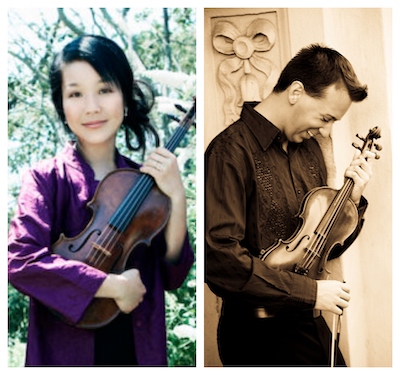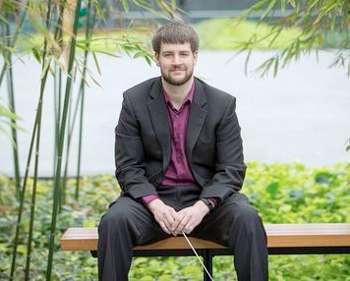by Jarrett Hoffman

Another intriguing pairing is the program itself, which places J.S. Bach and his popular Concerto for two violins in d side by side with the Symphonie Concertante in G of Joseph Bologne, Chevalier de Saint-Georges, an 18th-century Black composer who is only recently receiving his due recognition both in the history books and the concert hall.
The free concert airs on YouTube on the morning of Tuesday, April 20, the fruits of a recording session held earlier this month at Trinity Cathedral and engineered by Paul Eachus, with video direction by Mathias Reed and cinematography by Robert Reiland.
“It has been a wonderful run of six years,” director David Ellis (below) wrote on the ensemble’s website. “We are so grateful to our loyal audience and patrons. We couldn’t have done this without you!” He also left the door open just a crack: “We anticipate other individual and small ensemble projects in the future on a more limited basis.”
In a telephone conversation from Mari Sato’s back yard, where the duo was enjoying a break from their rehearsals, Andrew Sords noted his fond memories playing Mendelssohn’s early Concerto in d with Earth and Air in 2018. “David Ellis and his wonderful musical mind got some great colleagues together,” Sords said. “It’s special to share the stage with him.”
Meanwhile, Sato is working with the ensemble for the first time. “I had heard of them for years, and I know it’s a fantastic group,” she said. “I’m sad that they will not be continuing, but I do feel an extra honor to be part of the last performance together. I think it will be celebratory. It was David’s idea to put this wonderful program together, and we’re very excited to play it.”
The two violinists have a long history together, going back about twenty years ago to when Sords was a student at Shaker Heights High School. One day his orchestra class received four visitors: “a quartet by the name of the Cavani,” he said. “I was so inspired by their talk about the Shostakovich and Bartók quartets, and the examples they played.”
On top of that, he and seven classmates performed the last movement of the Mendelssohn Octet in front of the Cavani — a quartet which of course included Sato, who only recently left the group after nearly a quarter-century. “And that was my first interaction with Mari all those years ago.”
Sords ended up attending the Cleveland Institute of Music, “where of course the Cavani was part and parcel of the excellent chamber music program there, along with Peter Salaff. So it’s great when your mentors and the folks you look up to can become your friends and colleagues.” He also pointed to members of the piano faculty at CIM such as Anita Pontremoli and Elizabeth DeMio — “these wonderful personalities that you learn from when you’re 18, 19, 20,” he said. “And of course you still learn from them when they say yes to doing a concert with you years later.”
As for this particular duo partnership, it originated a few years ago during a conversation at Sato’s house, where Sords was on his “first or third glass of wine,” he said, laughing. Wouldn’t it be fun sometime to put together a program with two violins, he wondered aloud. “We could be, like, the Dueling Divas, though I’m not sure which of us is the diva here.”
That duo format comes with one big bonus. While concertos and sonatas have been Sords’ “whole existence,” he said, “it’s so much more rewarding to have a friend there with you to put together a sort of double act.” He also pointed out the number of deserving works for that combination, by composers such as Moszkowski, Sarasate, Wieniawski, Ysaÿe, and now their most recent discovery, the Bologne. Plus, there’s “the virtually unknown Mozart Concertante in C Major, which is something on the docket that will likely happen next year,” Sords said.
“I had never heard of it until Andrew introduced me to it,” Sato said. “And that would be an interesting pairing with the Bologne down the road, too.

Racism has continued to affect the legacy of Bologne. “There are these underrepresented composers who certainly are not in the lexicon of figures we learn about in conservatory, but who absolutely should be,” Sords said. He described this particular work as charming and similar to music by Viotti and Mozart from the same time period, “except he has his own language.” Sords also pointed out the composer’s fascinating life and variety of interests. “It sounds like he was quite the personality with his swordsmanship and his music-making.”
Sato noted that while Bach wrote only one concerto for two violins, Bologne wrote several. “I guess it was a very popular medium in France during that time,” she said. “I’m fascinated by his work. There are not very many editions out there for this piece, but I imagine that it will get more performance opportunities as the years go on.”
Digging into genre, I asked whether either player hears much of a difference in the format between this double concerto and symphonie concertante. “Not at all,” Sords said. “They’re really glorified chamber music pieces, especially the Bach. The first-violin and second-violin ripieno parts are doubling what we’re doing numerous times, so it feels like a sextet or an octet.”
“I’m in complete agreement about the chamber music feel of both pieces,” Sato said. “The solo parts are so integrated with the tutti and the ripieno parts. And you’ll see also in the second movement of the Bologne that the melody is often in the orchestra, with a sort of obbligato being played by the soloists.”
Looking ahead at the calendar, the Dueling Divas have several concert dates lined up in the next year and a half. The social side of that is one thing to look forward to. “There’s nothing better than playing a concert with pals, and then being able to celebrate with a glass of wine afterwards,” Sords said.
“But I’m also constantly learning from my colleagues at every rehearsal and every juncture, so I guess I’m also selfishly furthering my education by having these wonderful colleagues around. We’ve got concerts with Liz DeMio and Daniel Overly, and it’s just a party on stage when you’ve got somebody to bounce ideas off.”
Published on ClevelandClassical.com April 14, 2021.
Click here for a printable copy of this article




